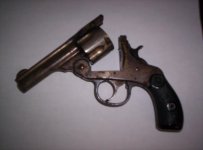You're going to have to post a lot more information, CTGE is an old abbreviation for Cartridge. At this point the only thing that is known is that you have a 38 caliber revolver.
Note, the notation of 38 S&W CTGE would indicate production pre-dating 1900 and the actual caliber is the 38 S&W, a caliber the pre-dates the more modern 38 Special. However, some versions of the older top break revolvers were produced into the late 30's so the 38 S&W does have a fair amount of overlap with the later 38 spl..
Pictures would be of most help. Lacking that you need to post as complete a description as possible. To help with that, here are some questions you need to answer.
1) How many shots in the cylinder, 5 or 6?
2) Is it a top break or does the cylinder swing open?
3) Does it have a hammer or is it a double action hammerless model?
4) What EXACTLY is stamped on the barrel, letter for letter in sequence, Left Side, Right Side, Top, and Bottom? Note, describe each surface seperately.
5) What is the barrel length? BTW this is measured from the front surface of the cylinder to the end of the barrel.
6) Until the above questions are answered, the serial number isn't of much help, Smith & Wesson has re-used serial number ranges at multiple points in it's history. Also note, ANY letter preceding the serial number is PART of the serial number, so don't leave that out.
BTW, if there is a letter V proceeding the serial number it's a dead easy identification, it's one of the Victory series provided to England during WWII as part of the Lend Lease program. These were somewhat special version of the Military & Police revolver in the English 38/200 caliber, a heavy bullet variant of the 38 S&W that predated the 38 spl.. Many of these guns were brought back after the war and re-chambered for the 38 spl. and converted Victory models don't have much value to a collector.

